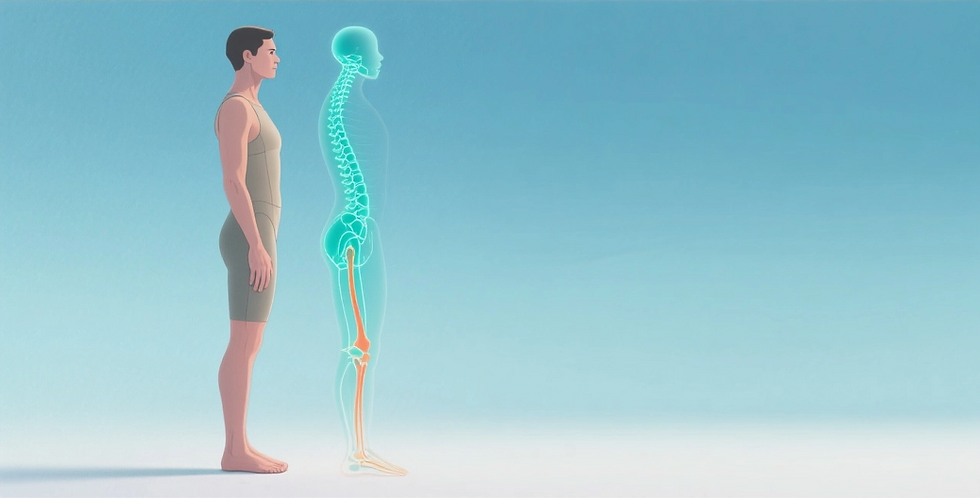Tight Hamstrings? The Hidden Biomechanics of Modern Living (and How I Found the Solution)
- Luc

- Jan 9
- 5 min read
Updated: Feb 3
Introduction
Do your hamstrings feel tight no matter how much you stretch or work on your flexibility? You’re not alone. Chronic hamstring tightness is one of the most common complaints today, and it’s not just about flexibility—it’s about how your body moves and adapts to modern living.
In this post, we’ll explore the biomechanics of hamstring tightness, how modern footwear and sedentary lifestyles contribute to the problem, and why even the most effective techniques, like PDT-R (Proprioceptive Deep Tendon Reflex), can only provide temporary relief if the root cause isn’t addressed.
This is the first part of our series, Unraveling the Root Causes of Tight Muscles, where we’ll uncover the hidden factors behind muscle tightness and provide actionable solutions to help you move and feel better.

For years, I wondered why so many people with injuries also had postural imbalances, like a lower shoulder or recurring joint pain. During my first year as a personal trainer, I worked with clients who struggled with knee, ankle, and back issues. Despite following traditional approaches, I noticed that these methods often failed to address the root cause of their problems.
Determined to find better solutions, I began researching alternative methods. In 2020, I earned my Brain Coach Certification from Posturepro, and in 2021, I trained in PDT-R. These techniques transformed not only my clients’ results but also my own.
The Brain Coach Certification helped me fix my posture and improve my flexibility. I also transitioned to minimalist footwear, which has kept me pain-free ever since. Over the years, I’ve attended numerous courses—from personal training to strength and mobility coaching—but nothing expanded my knowledge as profoundly as these two methods.
I’ve seen countless clients walk into my practice frustrated by chronic tightness and leave amazed at how quickly PDT-R can restore balance. One client, for example, had been struggling with tight hamstrings for years. After just one session, they felt immediate relief. By combining this technique with posture alignment, we ensured their results lasted.
The Role of the Hamstrings in Your Body
The hamstrings are a group of three muscles—biceps femoris, semitendinosus, and semimembranosus—that run along the back of your thigh. These muscles play a crucial role in:
Hip extension: Moving your leg backward.
Knee flexion: Bending your knee.
Postural support: Stabilizing the pelvis and spine during movement.
When your hamstrings are tight, they can restrict your range of motion, alter your posture, and even contribute to lower back pain. But here’s the thing: tight hamstrings are often a symptom, not the root cause.
Why Are Your Hamstrings Always Tight?
Hamstring tightness is rarely caused by the hamstrings themselves. Instead, it’s often the result of compensations caused by other factors, such as:
1. Modern Footwear
Shoes with elevated heels, narrow toe boxes, and excessive cushioning alter your body’s natural alignment.
Elevated heels tilt the pelvis forward, increasing tension in the hamstrings as they work to stabilize your posture.
Narrow toe boxes weaken the intrinsic muscles of the feet, leading to compensatory tension in the posterior chain (hamstrings, calves, and lower back).
2. Prolonged Sitting
Sitting for long periods shortens the hip flexors and places the hamstrings in a lengthened, passive position. Over time, this can lead to muscle imbalances and a feeling of tightness.
3. Poor Posture
An anterior pelvic tilt (forward-tilted pelvis) caused by weak glutes and tight hip flexors places constant strain on the hamstrings.
Slouched sitting or standing positions disrupt the natural alignment of the spine and pelvis, further increasing hamstring tension.
4. Inefficient Movement Patterns
Heel-strike walking or running (common with modern shoes) places excessive strain on the posterior chain, including the hamstrings.
Lack of core stability forces the hamstrings to compensate for weak abdominal and gluteal muscles.
The Quick Fix vs. The Root Cause
Techniques like PDT-R can resolve muscle imbalances and provide immediate relief from hamstring tightness by resetting the nervous system and restoring proper muscle function. I personally love PDT-R because it can release tension and improve mobility in just a few minutes.
However, even with effective techniques like PDT-R, hamstring tightness will persist if the root causes—like modern footwear or poor movement habits—aren’t addressed.
Here’s why:
Modern footwear disrupts natural biomechanics: Elevated heels, narrow toe boxes, and cushioning create compensatory patterns that lead to recurring tension in the hamstrings.
Lifestyle factors reinforce the problem: Prolonged sitting, poor posture, and inefficient gait mechanics perpetuate the cycle of tightness.
To achieve long-term relief, it’s essential to address these underlying factors. This means making changes to your footwear, movement patterns, and daily habits.
Why Stretching Alone Doesn’t Work
If you’ve been trying to fix your tight hamstrings with endless stretching, you’ve probably noticed that the relief is temporary at best. That’s because stretching doesn’t address the root cause of the problem.
Here’s why:
Tight hamstrings are often compensating for weak or inactive muscles elsewhere. Stretching them without addressing the underlying imbalance can make the problem worse.
The nervous system plays a role: Tightness is often a protective mechanism triggered by instability or poor movement patterns.
To truly resolve hamstring tightness, you need to focus on:
Strengthening weak muscles (e.g., glutes, core, and feet).
Restoring natural movement patterns (e.g., proper gait mechanics).
Addressing lifestyle factors (e.g., footwear and sitting habits).
How I Can Help: My Services
If you’re tired of dealing with tight hamstrings and want a solution that works, I offer two powerful services designed to address both the symptoms and the root causes of muscle imbalances:
1. PDT-R (Proprioceptive Deep Tendon Reflex)
This technique resolves muscle imbalances and releases tension in as little as 5 minutes by resetting the nervous system and restoring proper muscle function.
It’s quick, painless, and highly effective.
2. Posture Alignment Based on Proprioception
For long-term results, I focus on correcting posture by addressing the feet and eyes—two key areas that influence your body’s alignment and movement patterns.
By improving proprioception, we can restore natural biomechanics and prevent recurring issues like hamstring tightness.
What to Expect:
A personalized assessment to identify the root cause of your tight hamstrings and postural imbalances.
Immediate relief through PDT-R.
A long-term plan to correct your posture and movement patterns, ensuring lasting results.
Ready to Get Started?Book a Session Today and take the first step toward pain-free movement and better posture.
Actionable Steps to Start Fixing Tight Hamstrings
Here are three simple steps you can take today to start addressing the root causes of hamstring tightness:
Assess Your Footwear
Check your shoes. Do they have elevated heels or narrow toe boxes? If so, consider transitioning to minimalist footwear (we’ll cover this in detail in the next post).
Incorporate Movement Breaks
If you sit for long periods, set a timer to stand up and move every 30–60 minutes. Try simple stretches like standing forward folds or lunges to release tension in the posterior chain.
Strengthen Your Posterior Chain
Add exercises like glute bridges and dead bugs to your routine to strengthen the muscles that support your hamstrings.
What’s Next in the Series?
This is just the beginning! In the next post, we’ll dive deeper into how modern footwear reshapes your posture and gait mechanics, and why this is a major contributor to hamstring tightness.
Stay tuned for actionable tips on transitioning to minimalist footwear, improving your gait, and restoring natural movement patterns.
Conclusion
Hamstring tightness isn’t just about flexibility—it’s a sign that your body is compensating for deeper imbalances. While techniques like PDT-R can provide immediate relief, the long-term solution lies in addressing the root causes, such as modern footwear and lifestyle habits.
Are you ready to take the first step? Start by assessing your footwear and making small changes to your daily routine. And don’t forget to check back for the next post in our series!
Disclaimer
This blog is for informational purposes only and is not intended as medical advice. It is meant to complement other health and wellness methods, not replace professional medical care. By implementing the suggestions in this blog, you acknowledge that you are doing so voluntarily and take full responsibility for your health and well-being.





Comments